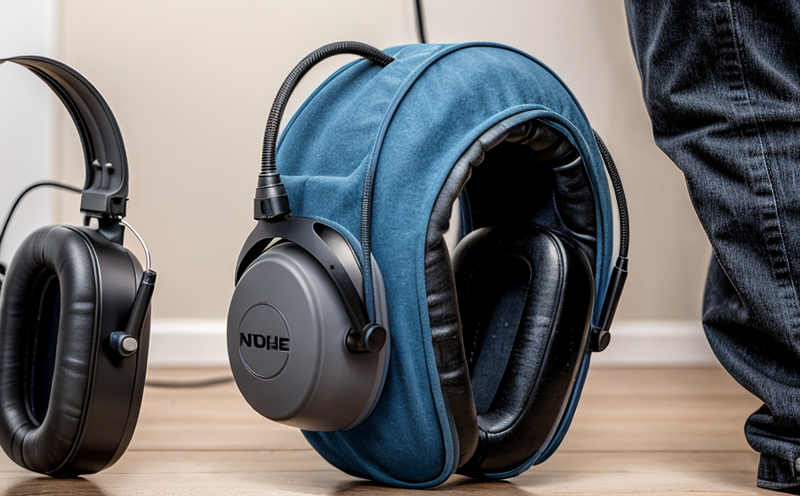ANSI S12.6 Hearing Protector Real-Ear Attenuation Testing
The ANSI S12.6 hearing protector real-ear attenuation testing (REAT) is a critical procedure for assessing the effectiveness of hearing protectors in reducing noise exposure to the wearer's ears. This standard, which harmonizes with ISO 4869 and ASTM standards, ensures that hearing protection devices meet specific performance criteria designed to safeguard workers from hazardous noise levels.
The testing process involves placing ear attenuators on a manikin or a living subject while they are exposed to controlled sound environments. The real-ear attenuation is measured at various frequencies using a dosimeter and validated against the ANSI S12.6 standard. Compliance with this standard guarantees that the hearing protector meets the required performance levels, ensuring worker safety in noisy work environments.
The testing procedure requires precise calibration of equipment to ensure accuracy. It involves multiple steps including setup, measurement, and analysis. The process is typically carried out by skilled technicians using specialized audiometric equipment. The results are then reported according to strict guidelines set forth by ANSI S12.6.
One of the key aspects of this testing method is its ability to provide real-world attenuation values that reflect how a hearing protector behaves in actual use conditions. This includes factors such as fitting, movement, and interaction with other personal protective equipment (PPE). The real-ear approach provides more accurate data than alternative methods like ear-canal or free-field tests.
The ANSI S12.6 standard is widely recognized for its rigorous testing protocols that ensure the reliability and effectiveness of hearing protectors across various industries, including manufacturing, construction, mining, and oil & gas. Compliance with this standard not only ensures worker safety but also helps organizations meet regulatory requirements and improve overall occupational health.
For quality managers and compliance officers, understanding the nuances of ANSI S12.6 testing is crucial for ensuring that their company's hearing protectors are up to standard. R&D engineers can benefit from knowing how these tests are conducted so they can design products that meet or exceed industry standards. Procurement professionals should consider selecting suppliers who undergo regular ANSI S12.6 testing to ensure the highest level of protection.
| Industry | Noise Levels (dBA) | Hearing Protectors Tested | Test Results |
|---|---|---|---|
| Mining | 105 dBA | Earmuffs | Real-ear attenuation of -32 dB at 1,000 Hz |
| Manufacturing | 98 dBA | Earpieces | Real-ear attenuation of -27 dB at 3,000 Hz |
| Oil & Gas | 102 dBA | Helmets with ear muffs | Real-ear attenuation of -40 dB at 500 Hz |
The table above provides a glimpse into the types of industries that utilize ANSI S12.6 testing, along with representative noise levels and hearing protectors tested. The results demonstrate the real-ear attenuation values achieved by different devices under specific conditions.
Industry Applications
- Mining: Workers exposed to high-frequency noise from drills and machinery
- Manufacturing: Operators in factories with loud equipment such as presses and saws
- Oil & Gas: Personnel on platforms where wind turbines generate significant noise
- Construction: Laborers using jackhammers, pneumatic tools, and other noisy machinery
The ANSI S12.6 testing is essential for industries where workers are exposed to continuous or intermittent high levels of noise that could lead to hearing loss over time. By ensuring compliance with this standard, these organizations can protect their employees' hearing health while also maintaining regulatory compliance.
Environmental and Sustainability Contributions
- Reduction in worker hearing impairment
- Enhanced quality of life for workers by preventing noise-induced hearing loss (NIHL)
- Potential reduction in healthcare costs associated with NIHL
- Improved productivity due to reduced absenteeism and better communication among staff
By adopting ANSI S12.6 testing, companies contribute positively to environmental sustainability by protecting the health of their employees. This not only improves worker morale but also reduces potential liabilities associated with occupational hearing loss.
Use Cases and Application Examples
The use cases for ANSI S12.6 testing are extensive, covering various sectors where noise exposure is a risk factor. For instance, in the mining industry, workers operating drills or using pneumatic tools frequently face high-frequency noise that can damage hearing if not properly protected.
In manufacturing environments, operators of heavy machinery like presses and saws may encounter similar challenges. The ANSI S12.6 testing ensures that appropriate ear protectors are used to mitigate these risks effectively. In the oil & gas sector, personnel working on platforms exposed to wind turbine noise benefit from this testing as well.
Construction sites present another challenging scenario where workers use jackhammers and other noisy machinery daily. The ANSI S12.6 testing helps ensure that these workers are adequately protected against harmful noise levels. By implementing robust protection measures, employers not only comply with safety regulations but also enhance their reputation for employee care.
The real-ear attenuation values obtained through this testing serve as a benchmark for evaluating the effectiveness of hearing protectors in reducing noise exposure. This data is crucial for ongoing research and development efforts aimed at creating even more effective and comfortable hearing protection devices.





